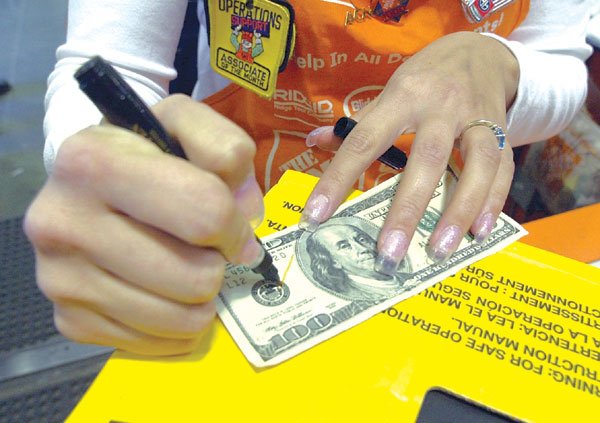GILROY
– This is not only the most wonderful time of year for boys and
girls injected with holiday magic but also for crafty criminals
hungry to take advantage of the seasonal cheer.
GILROY – This is not only the most wonderful time of year for boys and girls injected with holiday magic but also for crafty criminals hungry to take advantage of the seasonal cheer.
As throngs of intense shoppers continue to flock to local retail stores throughout Gilroy, people trying to pass counterfeit money often follow. And while most stores are prepared for the criminals magnetized to the large crowds and chaotic shopping environments, many ordinary shoppers are not.
“In counterfeit cases, the person stuck holding the bill is stuck with the loss,” said Sgt. Jack Robinson, a detective with the Gilroy Police Department who investigates counterfeiting in the city. “Cash is still used by many people – selling a used car, a TV, cashing a check at a check-cashing service – so it is important to always check the money. Most people never even think about (counterfeiting), but there are people out there who do this for a living.”
Acknowledging the potential loss posed by counterfeiters during the bustling shopping season, local retail stores have taken action to protect themselves.
Home Depot, 8850 San Ysidro Ave., trains all of its cashiers how to quickly identify a counterfeit bill. While all $50 and $100 bills are marked with a special marker designed to smear the ink on a bogus bill, the examination of smaller bills is up to the discretion of the cashier, Home Depot Manager Darren Perez said.
The higher the bill the more likely it is to be counterfeit, as counterfeiters usually make their money from the change they receive from a purchase, Robinson said. Home Depot already has seized several counterfeit bills this holiday shopping season, according to Perez.
“We utilize touch and feel to identify the bill, but we also have a black light in back like the banks do to test the watermark,” Perez said. “We tell our employees to study real bills so they can recognize the fakes. If there are any questions, the cashier will call the manager, and we go from there.”
Recent technology like inkjet printers has made it possible for criminals with basic equipment to try their hand at reproducing U.S. Treasury approved currency. For instance, inkjet printers accounted for 43 percent of arrests made by the Secret Service for counterfeiting in 2000 – up significantly from the .5 percent of inkjets used for counterfeiting in 1995, according to the Treasury Department. Counterfeiting any amount of money is a felony offense.
“We’ve seen different types of (counterfeiting) techniques used lately, but the interesting thing is that they all seem to come at the same time,” Robinson said. “That’s why we always see the rise in the Christmas season – the criminals know the lines are long and the cashiers are in a hurry.”
Tiffany Pena, the accounting manager at Wal-Mart, 7900 Arroyo Circle, said during her time at the store $20, $50 and $100 bills have come back from the bank marked as counterfeit, leaving the store at a loss. Pena said the hardest part of dealing with counterfeit money is training her cashiers to keep an eye out for fake bills while at the same time remaining courteous to the customer.
In some circumstances, the person trying to pass the fake bill does not know it’s counterfeit, and they are surprised when they are questioned by a cashier or manager, Pena said.
“We try to do it discreetly but that isn’t always possible, and people get upset,” said Pena, whose employee confiscated a fake $100 on Friday. “If the person legitimately didn’t know about the bill, they will wait for the police – they could be out a lot of money – but otherwise they always make an excuse and leave before (the police) come.”
The Gilroy Police Department does work with a few local retailers to help them prevent counterfeit money from being passed at their stores but only if the stores contact the department, Robinson said.
“We tell them to look for differences in the bills, not similarities,” Robinson said. “The bottom line is that except for when you’re at the bank, anytime you exchange a large bill you are at risk along with the person exchanging it.”
For more information on counterfeit money, go to www.bep.treas.gov.













